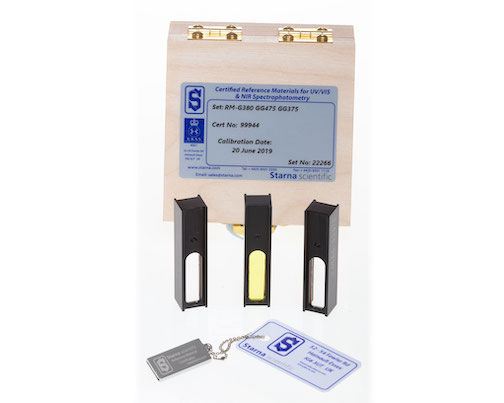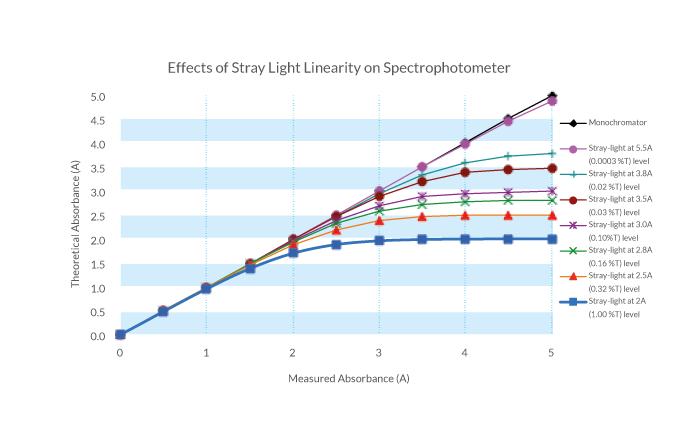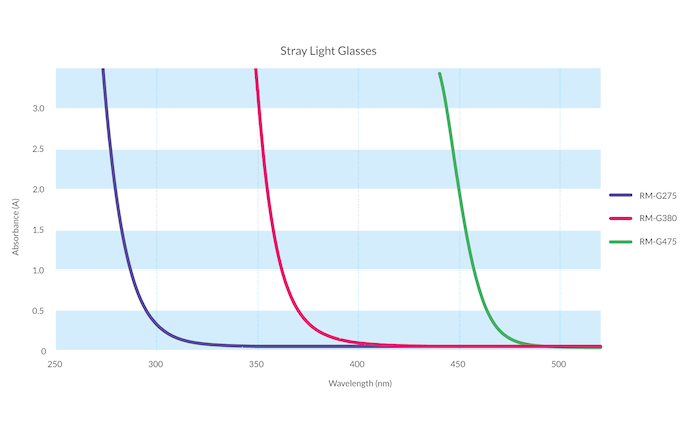

| Description | Filters with cutoffs in transmission at specified wavelengths |
|---|---|
| Primary Usage | Detection of Stray Light |
| Useable Range | 280nm, 360nm, 450nm, depending on the material |
| Physical Configuration | Glass filters mounted in aluminum frames |
| NIST Traceability | Each set is supplied with a Certificate of Analysis and NIST Traceability |
| ISO Accredited | Accredited by UKAS ISO 17025, ISO Guide34 and ISO 9001 |
Product Description
View/Download Comprehensive Data Sheet for Glass Stray Light Reference
Glass cut-off filters that allow stray light to be checked, nominally at 280 nm,360 nm and 450 nm. Note that variations from melt to melt of the glass can cause variation in these wavelengths, up to ± 10 nm, so each Starna filter is individually certified. Sliding window covers are provided to protect the surface from damage when not in use.
Stray light, also called Stray Radiant Energy or Power, is any light reaching the detector that is outside the Spectral Band Width selected for analysis by the monochromator. It can be due to optical imperfections or stray reflections within the monochromator itself or to light leaks or other effects in the rest of the optical system. As the detector cannot discriminate between the analytical wavelength and the stray light, the stray light contributes to the detector signal and introduces an error in the measured absorption. The stray light is not absorbed even at high concentrations of the absorbing species, so its effect is a negative deviation from the linear relationship between concentration and absorbance (the Beer-Lambert law) on which most quantitative determinations are based.
Stray light is wavelength and instrument dependant. It can be present at any wavelength but is most noticeable when the energy throughput of the system at the analytical wavelength is relatively low, and any stray light will be comparatively more significant. At these wavelengths, any deterioration in the instrument optics or light source will exaggerate the apparent stray light, so it is desirable to check it on a regular basis, as it is an excellent way of monitoring the condition of the instrument optics.
The usual way of assessing stray light is to measure, at the desired analytical wavelength, a sample that totally absorbs the radiation at that wavelength, but transmits at all other wavelengths. Any light detected by the instrument is then stray light.
Practically, the usual method is to use cut-off filters that cut off all light near the analytical wavelength and transmit at all higher wavelengths. The certified wavelength is that at which the spectrum transitions 2.0 A. Below this wavelength, within the indicated usable range, any indication of light transmission must be stray light.
Typical Spectra


How to Order
| Catalog Number | Description |
|---|---|
| RM-G275 | Stray Light Reference, Glass Filter, WG275 glass, 280nm cutoff |
| RM-G380 | Stray Light Reference, Glass Filter, GC380 glass, 355nm cutoff |
| RM-G475 | Stray Light Reference, Glass Filter, GG475 glass, 450nm cutoff |